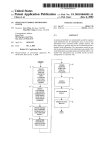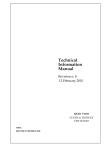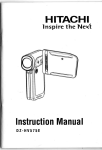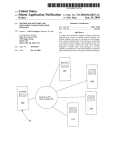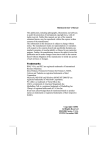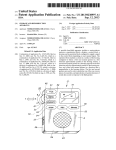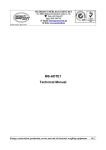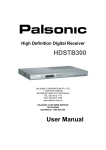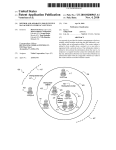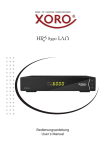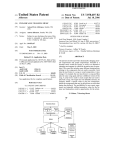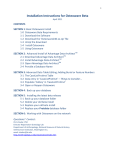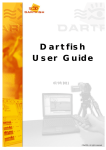Download System for policing junk e
Transcript
USOO8219627B2 (12) United States Patent Pang (54) US 8,219,627 B2 *Jul.10,2012 (10) Patent N0.: (45) Date of Patent: SYSTEM FOR POLICING JUNK E-MAIL MESSAGES (56) References Cited U.S. PATENT DOCUMENTS (75) Inventor: Stephen Y. F. Pang, Menlo Park, CA (113) 5,619,648 5,742,769 5,757,669 5,771,354 5,838,923 5,864,684 5,905,495 (73) Assignee: Fortune Communications, L.L.C., Dover, DE (US) (*) Notice: Subject to any disclaimer, the term of this patent is extended or adjusted under 35 U.S.C. 154(b) by 77 days. This patent is subject to a terminal dis claimer. A A A A A A A 4/1997 4/1998 5/1998 6/1998 11/1998 1/1999 5/1999 Canale et al. Lee et al. Christie et al. Crawford Lee Nielsen Tanaka et al. 5,978,566 A * 11/1999 Plank et al. ................. .. 709/206 5,999,932 5,999,967 6,003,070 6,023,723 12/1999 12/1999 12/1999 2/2000 Paul Sundsted FrantZ McCormick et al. A A A A (Continued) (21) Appl. No.: 12/729,186 (22) Filed: OTHER PUBLICATIONS Mar. 22, 2010 (65) Microsoft Corporation, “Microsoft Mail User’s Guide Windows and Presentation Manager Version”, 1992, 7 pages. Prior Publication Data US 2010/0325728 A1 TSW Inc., “TSW’s eFilter User Manual”, 1997, 13 pages. Dec. 23, 2010 (Continued) Related US. Application Data Primary Examiner * Minh-Chau Nguyen (60) Continuation of application No. 11/ 862,195, ?led on Sep. 27, 2007, now Pat. No. 7,685,242, which is a (74) Attorney, Agent, or Firm * StolowitZ Ford Cowger LLP division ofapplication No. 10/656,502, ?led on Sep. 4, 2003, now Pat. No. 7,275,082, and a continuation of (57) application No. 11/841,883, ?led on Aug. 20, 2007, now Pat. No. 7,779,080, which is a continuation of The system has a plurality of clients, each coupled together application No. 10/656,502, ?led on Sep. 4, 2003, now using a wide area network of computers, such as the Internet or an interne. Each of the clients is adapted to send an indi cation of an unsolicited e-mail message through an e-mail device for a display. The system also has a policing server Pat. No. 7,275,082, which is a continuation of applicationNo. 09/353,537, ?led onJul. 14, 1999, now abandoned. (60) ABSTRACT A system for policing an unsolicited e-mail communication. Provisional application No. 60/093,120, ?led on Jul. coupled to each of the plurality of clients through the wide 15, 1998. area network of computers. The policing server is adapted to receive the indication from at least one of the clients. The e-mail device comprises a SPAM icon on the display. The SPAM icon is adapted to send the indication from the client to the policing server. (51) Int. Cl. (52) (58) US. Cl. G06F 15/16 (2006.01) ..................................................... .. 709/206 Field of Classi?cation Search ................. .. 709/206 See application ?le for complete search history. 20 Claims, 11 Drawing Sheets [/2300 [3 07 If EGroupWise 4.141 [lie idit iiew Eend Inols window Help Main My lrnsh Cniqndqr Send Mml '=E- ’513 ‘4 Schedule 309 Printer Rules Emplyl Arrange Hide Mu' Min Ml Assign Tusk /315 Write Note Phone Message E/,317 %\319 /‘321 US 8,219,627 B2 Page 2 U.S. PATENT DOCUMENTS 6,028,602 6,167,434 6,189,026 6,199,102 6,249,805 6,421,709 6,453,327 6,493,007 7,127,680 7,275,082 7,685,242 7,779,080 2002/0016824 2/2000 Weiden?ller et al. 12/2000 Pang 2/2001 Birrell et a1. 3/2001 Cobb .......................... .. 6/2001 Fleming, 111 7/2002 McCormick et al. ....... .. 9/2002 Nielsen ....................... .. 12/2002 Pang 10/2006 Pang 9/2007 Pang 3/2010 Pang 8/2010 Pang 2/2002 Leeds ......................... .. OTHER PUBLICATIONS Courtney Macavinta, “FTC searches for spam solution”, Jun. 12, 1997, CNET News.com, pp. 1-2, http://news.cnet.com/FTS searches-for-spam-solution/2100-1023i3-200486.html. 709/206 Dennis Sheridan et a1 ., “Spam Hater: Freeware HelpsYou Flame Junk 709/206 Mailers”, PC World, Apr. 1997, 1 page. Paul Heltzel, “A New Line of Defense Against Spam”, PC World 709/206 Online, May 22, 1997, 1 page. Cheri Paquet, “CompuServe Offers Junk E-mail Filters”, IDG News Service, PC World Online, Sep. 24, 1997, 1 page. StolowitZ Ford Cowger LLP, Listing of Related Cases, Mar. 20, 2012, 2 pages. 709/207 * cited by examiner US. Patent Jul. 10, 2012 Sheet 1 0f 11 US 8,219,627 B2 101 103A,“ 103 ' 5*! FIG. 1 US. Patent Jul. 10, 2012 Sheet 2 or 11 210 MONITOR US 8,219,627 B2 j 200 } 220 601. ___.r———-l 270 RANDOM ACCESS MEMORY PROCESSOR ? i 280 DISK DRIVE I < /, "_' > 290/[ NETWORK INTERFACE INPUT F USER DEVICE KEYBOARD l 240) (230 ( 250 NEI WORK FIG. 2 US. Patent Jul. 10, 2012 US 8,219,627 B2 Sheet 3 0f 11 “m Enle:m m;n@ uWW4 m\E ?h\ETkm 5! B@i222E:53:4enMa2?$};“m3 __ \ 2%B1v:5U2SmH 5%raw2Lum. Snk¥ EH 5 84%“ T\ 5mg §\® £2: _05“:1290.35:2—;$0 m .9 L US. Patent Jul. 10, 2012 Sheet 4 or 11 US 8,219,627 B2 405 0| In Box 403 \ / |_|lIl|X File Edit View Send - f- 400 Actions Tools NOStephe SPAM! || From Windows | Subject U Affyme E Megan@NZ1 1 exam anOut -Reply U assoc g S caden S Fergu >i< U friend g [email protected] you! Anna_Tee_Uni@NZ RE: Hi LauraT@spam_emai What’s up [email protected] Joke?!? S ginn Julia_Tee@reuni0n g Help | Date 03/24l 401 407 subject: PinotNoir tasting 04/11 04/14_ 04/14 04/17 04/23 m hei g m intergr 2 U jokes 2 [email protected] No subject 04/24 Gua_Goong@Segam My New Personal E-mail Ad 05/04 [email protected] No Subject 05/01— U |amber 2 [email protected] 5 Magic 8 U Peop|e g [email protected] More email updates... [email protected] Jerry, Jerry -Fon/varded m Photo 2 [email protected] (Fwd) FW: Yellow Rock Roa 05/28 5 ricoh g [email protected] '2 U sun 5 Tee [email protected] Hello, from Yan Yan 06/07 Stefanie.H@Random Lost your keys???? -Fon/var 06/18 V | i | g 2 Eric’s new email | FIG. 4 05/08 05/08 05/23 06/02 Selected: 1 | Total: 44 US. Patent Jul. 10, 2012 Sheet 5 0f 11 US 8,219,627 B2 501 \ 503 \ K500 //| Mail From: <meesacai2@e'arthlink.ne‘l> File Edit /— From: 505/— To: View Send Actions Tools |_|El| X Windows <meesaocai2@earthlink. CC: townsend.gwai(“mercha BC: Syp Help X __ Close 507 /— Subject: |Get It Out There!!! 509 /— Message 511 | GET IT OUT THERE! L WHERE PEOPLE CAN SEE IT!!! 2‘ Remy _ . The greatest way of marketing this centruy IS undoubtedly direct e-mail. The ability to promote your product, service, website or MLM/Network Marketing _ —>__ _> Fon/vard ' have been dreaming of for over 100 years. And the greatest part about it is that it’s completely affordable. mail addresses for the following prices Attach: l Info _ V < ? header a Delete — > NO SPAM Date: 06/24/98 10:52pm |//| FIG. 5 \ 515 opportunity to millions instantly is what advertisers We e-mail your promotion to a list of our general e- \513 \514 \517 \519 US. Patent Jul. 10, 2012 Sheet 6 0f 11 ?d—?x (i START US 8,219,627 B2 601 >-/ 509 M l 603 OPEN E—MAIL */ 605 ENTER lN-BOX —~—~ // I VIEW INCOMING I , M MAIL V 609 OPEN 71/ DESIRED MAIL F 611 REMOVE SPAM E-M/ 613 @/ FIG. 6 US. Patent Jul. 10, 2012 Sheet 7 0f 11 US 8,219,627 B2 115 ' POSITION CURSOR ON ICON H/e/II _________Y__L_____V 17 L RECEIVE 529 REMOVE _,/ FROM REPLY A 719 CLICK ON ICON // [ RETV'O’V'E 731 REPLY E-MAIL FROM / DISTRIBUTION L!‘=T SEND "REMOVE" 121 REPLY To / SENDER I TRANSMIT REPLY TO TRANSMIT ACK 723 SENDER WITH L‘I/ "REMOVE" J33 )5 RECEIVE ACK % 737 O A STOP FIG. 7 US. Patent Jul. 10, 2012 Sheet 8 0f 11 US 8,219,627 B2 800 ’ 803 OPEN E-MAILl/ l1 805 ENTER-IN BOX 7/ VIEW 80? INCOMING / MAIL If \ 809 OPEN SPAM dJ/ ‘ 811 REMOVE SPAM {i/ 813 FIG. 8 US. Patent Jul. 10, 2012 US 8,219,627 B2 Sheet90f11 990 I kij , 929 917 POSITION ON #1,) REMOVE SPAM ICON 919 CLICK ON ICON ;/ ' SEND REMOVE NAME jo FROM LIST 933 921 4/ "REMOVE" SEND ACK -// , 923 TRANSMIT / STOP "REMOVE" o FIG. 9 935 US. Patent Jul. 10, 2012 Sheet 11 0f 11 US 8,219,627 B2 1100 RECEIVE JUNK E-MAIL 1110 ONE-TOUCH REMOVAL OF JUNK E-MAIL 1120 LOG CHARACTERISTICS OF JUNK E-MAIL 1130 LOG REMOVAL REQUEST 1140 SEARCH LOG FOR MATCH? YES If 1150 NOTIFY RECIPIENT f 1160 NOTIFY JUNK E-MAIL ISP OF VIOLATION v/ 1170 NOTIFY ISP OF VIOLATION NOTIFY ENFORCEMENT AUTHORITIES FIG. 11 US 8,219,627 B2 1 2 SYSTEM FOR POLICING JUNK E-MAIL MESSAGES motorized vehicles such as cars or trucks, and airplanes, jets, and the like to physically transport mail throughout the United States. Conventional postal systems are often reliable and cost ef?cient. They are so ef?cient that they are often CROSS-REFERENCES TO RELATED APPLICATIONS subject to many undesirable in?uences. One of these in?u ences is the routine transmission of unsolicited advertise ments, information, and the like to many households across This application is a continuation of 1 1/ 862,195 ?led Sep. 27, 2007 which is a continuation of US. application Ser. No 11/841,883 ?led Aug. 20, 2007 which is a continuation of the United States. On any typical day, an average household receives at least one, if not more than one, unsolicited adver US. application Ser. No. 10/656,502 ?led Sep. 4, 2003; and tisement. As merely an example, the advertisement can be for 1 1/862,195 is a divisional ofU.S. application Ser. No. 10/656, 502 ?led Sep. 4, 2003 which is a continuation of US. appli cation Ser. No. 09/353,537 ?led Jul. 14, 1999 which claims are routinely sent by companies in an attempt to secure a carpet cleaning, credit cards, and other goods or services that purchase from the household. In many cases, these unsolic priority to 60/093,120 ?led Jul. 15, 1998, hereby incorporated ited advertisements often burden the postal system, although for all purposes. the advertisers at least pay for the service. Additionally, households are burdened by the advertisements, which are thrown away. These unsolicited advertisements are also termed as “Junk Mail.” COPYRIGHT NOTICE copyright owner has no objection to the facsimile reproduc tion by anyone of the patent document or the patent disclosure Unfortunately, junk mail is not limited to use in only the conventional postal systems. In many wide area computer networking applications, junk mail is commonly sent to users in large groups, often thousands or perhaps millions of users. as it appears in the Patent and Trademark Of?ce patent ?le or For instance, a user of a well known wide area network of A portion of the disclosure of this patent document con tains material which is subject to copyright protection. The 20 records, but otherwise reserves all copyright rights whatso 25 ever. BACKGROUND OF THE INVENTION computers, which is known as the “Internet,” often receives numerous lines of junk mail, which has been coined as SPAM! In fact, SPAM refers to such unsolicited advertise ments that come to the user by way of electronic mail, also known as “e-mail.” The senders of SPAM are often termed The present invention relates generally to telecommunica tion techniques. More particularly, the present invention pro vides a novel technique, including computer codes, to reduce unwanted e-mail messages from a personal computer, work “spammers”. Unlike regular mail advertisers, spammers do 30 SPAM has become a signi?cant problem because the vol ume of SPAM is large. As a courtesy, and under the threat of station, or the like. These unwanted e-mail messages that possible legislation restricting SPAM, many distributors of were unsolicited are commonly referred to as “SPAM.” SPAM includes junk mail or junk e-mail messages including 35 get-rich-quick schemes, advertisements, adult web site infor mation, donation requests, political campaign information, and the like. A variety of techniques have been used to transmit written messages from one geographic location to another. In the early days, people or messengers were the sole means used to not pay for the privilege to send SPAM to recipients e-mail boxes. 40 SPAM now send SPAM with instructions to the recipients of the SPAM on how to be removed from the SPAM distribution list. In most cases, however, e-mail messages often do not include such instructions on how to remove a recipient from a junk e-mail distribution list. In the cases where instructions are provided, many draw backs exist. As merely an example, some of the ways to be carry written information from one person to another person. removed from the mailing lists is time consuming to the Although effective and still used today, messengers were limited by their physical abilities. That is, some messengers could not travel over rough terrain such as rocks, jungles, and other landscapes. Large bodies of water were also dif?cult to cross. Additionally, messengers generally could not travel recipient. Additionally, there are simply no standards on how recipients may be removed from such mailing lists. Further 45 require the recipient to perform time consuming tasks, such as sending a reply e-mail to the junk e-mail message and spe ci?cally typing a request to be removed from the mailing list, over long distances in a short period of time A human mes senger could only travel a few miles or tens of miles during a typical day. 50 Accordingly, messengers were replaced, at least in part, by carrier pigeons. More particularly, carrier pigeons were used to move small pieces of papers having written information thereon from one geographic location to another. Carrier pigeons were quite ef?cient in some applications but could not generally travel over substantial distances. Accordingly, a relay of ponies and human riders was used for long distance travel across the North American continent. This relay of 55 ponies was called the “Pony Express.” The Pony Express carried written communication in the form of mail on leather pouches carried on the relay of ponies across the United States. Although all of these techniques were somewhat effec tive, they were often costly, unreliable, and dif?cult to achieve. In the modern day world, a combination of transportation techniques are used in the postal system. These techniques include, among others, human carriers (e.g., mailmen), more, the techniques that are available to the recipient often 60 forwarding the e-mail message to another e-mail address and typing a request with speci?ed text requesting removal, con necting to a particular web site and following instructions for removal (incidentally, bene?ting the SPAM web site by pro viding an advertising “hit” for the web site), and the like. Filters have also been used or proposed to remove junk e-mail messages from a recipients e-mail. In fact, various programs have been developed in an attempt to ?lter-out junk e-mail messages from in boxes. Such programs appear to focus upon the email address, host source, the format of the message, the content, and the like. Typically such programs are programmed by the user to detect junk e-mail, and to automatically delete them so the user is not bothered by them, or automatically put into a junk folder. A drawback to such programs is that the user is forced to determine the criteria for ?ltering, a complicated task for the average user. Another 65 drawback to such programs is that the ?lters de?ned by the user, or pre- set may ?lter-out legitimate bulk e-mail messages that are of interest to the user, for example, e-mail messages US 8,219,627 B2 3 4 from special interest groups, product recall and product wam clients through the wide area network of computers. The policing server is adapted to receive the indication from at ing notices, valuable product promotions from legitimate businesses, complementary upgrade notices and bug patches least one of the clients. The e-mail device comprises a SPAM icon on the display. The SPAM icon is adapted to send the indication from the client to the policing server. Numerous advantages are achieved by way of the present invention over conventional techniques. As merely an example, the present invention provides an easy to use for software programs, freebees, and the like. One company developing products to enhance the use of ?ltering techniques has been Bright Light Technologies in San Francisco. The Bright Light system appears to disclose providing a central clearing house of identi?ed SPAM mes sages. Bright Light appears to use the SPAM data to form data ?les which are downloaded to Bright Light subscribers. The subscribers utilize the data ?les to create ?lters within their e-mail programs that then ?lter-out SPAM messages. method to remove unwanted or unsolicited e-mail messages. In some embodiments, the present invention is relatively easy to implement using pre-existing computer software. The present invention also is time ef?cient and relatively cost Bright Light appears to gather SPAM data by setting up ef?cient. The computer codes also allows a user to perma nently remove unwanted e-mail messages from a distribution list. Depending upon the embodiment, one or more of the advantages are achieved. These and other advantages are dummy or “probe” e-mail accounts with e-mail providers, for example, Juno.com, Excite.com, or the like. When these dummy accounts receive e-mail messages, Bright Light appear to automatically or manually determine whether the e-mail is SPAM. If the e-mail message is determined to be SPAM, characteristics of the e-mail message, such as sender and the subject text appear to be entered into the SPAM data ?le. described throughout the present speci?cation, and more par ticularly below. These and other embodiments of the present invention, as 20 well as its advantages and features are described in more detail in conjunction with the text below and attached One drawback with the current Bright Light technique is that automatic determination of SPAM may require a high level of AI programming and programming resources. Another drawback is that manual determination of SPAM BRIEF DESCRIPTION OF THE DRAWINGS 25 FIG. 1 is a simpli?ed block diagram of an e-mail system according to an embodiment of the present invention; FIG. 2 is a simpli?ed block diagram of a display according to an embodiment of the present invention; 30 embodiments of the present invention; FIGS. 6-9 are simpli?ed ?ow diagrams according to embodiments of the present invention; and FIGS. 10-11 are simpli?ed diagrams according to other embodiments of the present invention. may require round-the clock hiring of personnel and person nel resources. Yet another drawback with the current Bright Light tech nique is that use of such dummy or probe e-mail accounts are passive do not receive SPAM as would active e-mail accounts. It is well known that electronic mass marketers use a variety FIG. 3-5 are simpli?ed user interfaces according to of techniques for obtaining e-mail address lists than just who has an e-mail account. For example, marketers obtain e-mail address from user posts on various Internet sites such as news group sites, chat room sites, or directory services sites, mes 35 DESCRIPTION OF THE SPECIFIC EMBODIMENTS sage board sites, mailing lists, and identifying “mailto” address links provided on web pages. Using these and other similar methods, electronic mass marketers may effectively I. System Hardware obtain large numbers of mailing addresses, which become targets for their advertisements and other unsolicited mes sages. Mere passive accounts would thus not have the same 40 exposure to such mass marketers, as would e-mail accounts of real live web users. As a result, a reduced number of SPAM would recognize other variations, modi?cations, and altema e-mail messages may be sent to such dummy or probe 45 accounts. FIG. 1 is a simpli?ed block diagram of an e-mail system 100 according to an embodiment of the present invention. This diagram is merely an illustration and should not limit the scope of the claims herein. One of ordinary skill in the art From the above, it is seen that an improved technique for removing and preventing repeat junk e-mail messages is highly desired. tives. Among other features, the system 100 is a wide area network of computers such as, for example, the Internet. The network of computers includes workstations or computer terminals 103, which can be IBM compatible personal com puters (i.e., PCs), workstations, network computers (i.e., SUMMARY OF THE INVENTION 50 NCs), remote computing devices, television sets, set-top boxes or other computer-like devices. These computers are According to the present invention, a technique for remov ing junk e-mail messages from a system of computers over a wide area network is provided. In an exemplary embodiment, the present invention provides a technique for easily viewing and removing SPAM without opening it. The technique can coupled through lines 105 to the Internet 101, which includes a variety of servers and other computers. As merely an example, one of the servers is shown as server 107. 55 Server 107 can be any suitable server that distributes unso licited advertisements such as junk mail. Server 107 is coupled to the Internet through line 109, which can be through an Internet service provider, which is commonly permanently remove the SPAM in some embodiments. The technique also provides for enforcement and reporting of SPAM to SPAM policing servers. The system has a plurality of clients, each coupled together known as an ISP. Server 107 often includes su?icient memory to store information such as advertisements and the like. The memory can also store an e-mail distribution list. The memory can be based on a hard drive, a ?oppy drive, tape, or using a wide area network of computers, such as the Internet or an interne. Each of the clients is adapted to send an indi depends upon the application. In a speci?c embodiment, the present invention provides a system for policing an unsolicited e-mail communication. cation of an unsolicited e-mail message (or forward the e-mail message) through an e-mail device for a display. The system also has a policing server coupled to each of the plurality of 60 other storage media. Of course, the type of memory used 65 The e-mail distribution list can include e-mail addresses to one ofa plurality ofcomputers 103A, 103B, 103C, and 103D, which can correspond to users. The e-mail distribution list is US 8,219,627 B2 5 6 often compiled from other e-mail distribution lists that are embodiment may also utilize web-based e-mail providers, such as Hotmail,Yahoo!, Excite, or the like; subscriber-based e-mail providers, such as America On Line (AOL), Com puserve, Prodigy, Microsoft Network (MSN) or the like. Still other embodiments may run with existing e-mail ?ltering software, such as Spam Wall from Bright Light, and the like. Many other systems, such as MacOSTM from Apple Cor poration, running upon G3 based microprocessors, or often accumulated from other servers or even purchased. The e-mail distribution list can also be formed by adding the e-mail addresses of users of selected sites. E-mail distribution lists can often range in hundreds, thousands, or even millions of users. As merely an example, a typical e-mail distribution list is often about thousands or even millions of e-mail names and greater. Of course, the type of e-mail distribution list depends upon the application. SolarisTM from Sun Microsystems or UNIX running upon a SPARCstation, and the like can also be used. Each of these computers can be at a user site such as a home, corporate address, or remote location. Periodically, The system above discloses examples of con?gurations that embody the present invention. It will be readily apparent each of these computers receives an unsolicited e-mail mes sage such as an advertisement from server 107 or a plurality computers by way of the Internet from one or more servers. to one of ordinary skill in the art that many system types, con?gurations, and combinations of the above devices are suitable for use in light of the present disclosure. Of course, Given the ef?ciency of the e-mail system of the Internet, the the types of system elements used depend highly upon the of servers. Literally hundreds, thousands, or even millions of unsolicited e-mail messages can be sent to one or more of the user of the computer can receive many e-mail messages from a large number of servers. These servers can send desirable advertisements as well as many undesirable advertisements. As merely an example, the advertisement can be for a car, a application. 20 ment, the text parsing routine automatically parses the junk e-mail message and determines the speci?ed method for removal from the mailing list. For example, the text parsing book, or other consumer products. Additionally, the adver tisement can be for “sensitive material” such as an adult Web Site or other materials. The present invention provides a tech nique to remove these unwanted e-mail messages in an e?i In one embodiment of the present invention, a text parsing routine can be implemented and included. In such an embodi routine can determine that a junk e-mail message should be 25 cient way. Before discussing details of the present invention, “replied to” with the text “remove”, “unsubscribe”, or the like in the subject line, in the body of the e-mail message, and the details of a computer according to the present invention are like. As another example, the text parsing routine can deter shown by way of FIG. 2 below. FIG. 2 is a simpli?ed block diagram of a system 200, according to an embodiment of the present invention. This diagram is merely an illustration and should not limit the scope of the claims herein. The system 200 includes a monitor 210, a computing system 220, a user input device 230, a network interface 240, and a keyboard 250. Computing sys mine that a junk e-mail message should be forwarded to a tem 220 preferably includes familiar components such as a processor 260, and memory storage devices, such as a random access memory (RAM) 270, a ?xed disk drive 280, and a 30 merely another example, the routine can determine that a speci?c web site shouldbe contacted using a web browser and speci?c acts performed such as clicking on a button on the 35 tangible media for storage of computer programs, e-mail messages, audio and/or video data, and code implementing embodiments of the present invention. Other types of tangible e-mail message. In one embodiment, as will be described below, when the user clicks upon the SPAM icon, the junk e-mail message is 40 45 (ROMs), ASICs, battery-backed volatile memories, and the 50 be a cable/DSL/telephone modem, an Ethernet or fast Ether net interface, a LocalTalk connection, or the like. As disclosed 55 such as the Internet, an Intranet, an IPX network, private tunnel, local area network (LAN), WAN, and the like. In a preferred embodiment, computing system 220 includes a microprocessor, such as a PentiumIII from Intel Corporation, a K-7 processor from Advanced Microdevices, or the like running Windows98TM operating system from 60 In another embodiment, when a junk e-mail has been removed by selecting the SPAM command or by clicking on the SPAM icon, a log is maintained of the incoming junk e-mail message, the source of the junk e-mail message, the product advertised in the e-mail message, or the like. Further, a log is maintained as to when the reply e-mail, to whom the reply e-mail is sent to, actions taken, or the like. Such logs are valuable as to tracking junk e-mails and to demonstrate whether the requests for removal have been respected. If a junk e-mail source repeatedly ignores removal requests, the logs may provide grounds for ISPs to terminate junk e-mail sender’s accounts, may provide evidence to governmental authorities, and the like. In still another embodiment, the logs may be forwarded to the policing server for further action. Microsoft Corporation of Redmond, Wash., BeOS, LINUX, In light of the disclosed embodiments, enhancements to the present invention are envisioned. For example, it is envi or the like. sioned that users will be able to de?ne custom actions and The embodiment may include an electronic mail (e-mail) client application, such as Netscape Messenger, GroupWise, Eudora, Microsoft Outlook, Pegasus Mail, or another typical e-mail program for reading and managing e-mail. The for removal from the e-mail mailing list is generated and the message is deleted. In some embodiments, the e-mail mes sage is transferred to trash. such as CD-ROMs and bar codes, semiconductor memories such as ?ash memories, stick memories read-only-memories above, the computer network may be any type of network not only replied to using the user’s e-mail program, but is also deleted or purged from the user’s in box. The e-mail message may also be forwarded to a centralized clearing house of SPAM messages, called a SPAM policing server or policing server. Thus with a single click of the remove icon, a request media include SRAM, ?oppy disks, optical storage media like. Network interface 240 may be any type of interface to a computer network. For example network interface 240 may web site. Other types of actions are contemplated in altema tive embodiments of the present invention and can depend upon the type of removal instructions speci?ed by the junk system bus 290 interconnecting the above components. User input device 230 may include a mouse, a trackball, a key board, a keypad, a joystick, a digitiZing tablet, a wireless controller, a microphone, or other input devices. RAM 270 and ?xed disk drive 280 are mere examples of speci?ed e-mail address, again with special text such as “delete”, “please remove”, and the like included therein. As 65 assign such actions to custom icons for display on the e-mail system. Some examples of custom user interfaces are shown below. US 8,219,627 B2 7 8 II. User Interfaces FIG. 3-5 are simpli?ed user interfaces according to embodiments of the present invention. These diagrams are merely illustrations and should not limit the scope of the In this embodiment, an e-mail message may also be sent to a SPAM policing server to indicate the receipt of a SPAM by the recipient. By way of the present user interface, the SPAM is removed claims herein. One of ordinary skill in the art would recognize without even opening it. The present user interface is easy to other variations, modi?cations, and alternatives. As merely use, by way of a simple position and click, and permanently an example, FIG. 3 shows a graphical user interface 300 for an removes the receivers name from the SPAM distribution list. e-mail system according to an embodiment of the present dow, and Help prompts. Accordingly, the receiver will not receive SPAM from the SPAM mailing list of [email protected], as long as the user’s name is permanently removed from the distribution list. In an alternative embodiment, the receiver of SPAM reads the SPAM message before removing it by way of a novel Additionally, the interface includes an in-box 301, an out box 303, and a trash can 305. As shown, the in-box, out-box, graphical user interface 500 or window shown in FIG. 5. This graphical user interface includes a variety of features such as and trash can be accessed by way of a mouse cursor posi tioned over a respective icon which allows entry. The e-mail also has a main menu 309, and a lower group of icons for accessing a calendar 311, a send mail program 313, a sched ule program 315, a task program 317, a note program 319, and a phone message program 321. Details of these particular a tool bar 503, sender ?eld 505, receiver ?eld 507, subject line 509, and e-mail message 511, which is SPAM. The interface also includes icons for closing the window 513, replying to invention. The graphical user interface 300 is one of many, if not the ?rst, window for the e-mail system. The user interface includes a variety of features such as a tool bar 307 that has at least features directed to File, Edit, View, Send, Tools, Win 20 includes an icon labeled “NO SPAM!” for permanently removing the SPAM. features can be found in one of many conventional e-mail systems such as, for example, GroupWise by Novell as well The NO SPAM! button removes the e-mail message or as other e-mail systems. The present invention allows for easy viewing and removal ofjunk e-mail messages or SPAM by ?rst entering the in-box 25 301. The in-box is entered by clicking a cursor by way of a mouse onto the in-box icon. Once the in-box is accessed, a graphical user interface such as the one 400 shown in FIG. 4 is displayed. The in-box user interface includes a variety of elements such as a root directory 403, which is in the name of the sender 514, forwarding the e-mail 515, information 517, deleting the e-mail 519, and others. The interface also disposes the e-mail message into the trash. The NO SPAM! button also sends a reply to the sender, which is [email protected] 501. The reply may send a mes sage such as a remove term which indicates that the receiver of the SPAM or Stephen would like to be removed from the spammer’ s distribution list using [email protected]. 30 In this embodiment, an e-mail message may also be sent to a SPAM policing server to indicate the receipt of a SPAM by the “Stephen” for example. The root directory includes a variety recipient. of sub-directories such as “friend” for example. As shown, the friend directory is highlighted by way of an outline. The friend directory is also open, as shown by the opened ?le By way of the present user interface, the SPAM is removed after opening it. The present user interface is easy to use, by way of a simple position and click, and permanently removes 35 folder. The friend directory receives a variety of e-mail mes sages which are sent to the main directory or directly to the friend directory. As shown, the e-mail messages come from the receivers name from the SPAM distribution list. In another embodiment, the user may have the option to select a “NO SPAM” function by right-clicking upon the e-mail message. Accordingly, the receiver will not receive SPAM from the “real” friends of the user or receiver such as the names listed, including Rosa S. Kim, Diane H. ElZingre, and others. Addi tionally, the friend directory includes junk mail, non- solicited 40 mail, or SPAM, as shown by the line item corresponding to “What’s up” 407, which is from [email protected]. The SPAM has not been opened but can be easily identi?ed by the user or recipient by the unknown e-mail name and message. In the present embodiment, the user can remove the SPAM 45 by simply clicking on the “NO SPAM!” icon 405, which is disposed around the periphery of the graphical user interface. The periphery of the graphical user space is outside of the region for the main text or body of the e-mail message. In some embodiments, the periphery of the graphical user inter face is a portion of a tool bar, for example, which is easy to access but substantially out of the way of the text. In still another embodiment, the user may have the option to select a “NO SPAM” function by right-clicking upon the e-mail mes 50 distribution list, and if the SPAM police server updates its ?lter data ?les. Although the above embodiments are shown by way of speci?c user interfaces, the present invention is much broader. In particular, the present invention can be applied to other e-mail systems and other types of interfaces. The inven tion can also be added to pre-existing systems without sig ni?cant limitations or the like. The invention is shown, in part, by the SPAM! icon, but is not limited. The present invention merely provides an easy to use technique for removing SPAM, removing the user’s name of a spammer’s e-mail distribution list, and for reporting the SPAM to a SPAM policing server. Details with regard to speci?c methods 55 sage. Here, the icon is displayed simultaneously with the many lines of e-mail messages, including titles and senders. The NO SPAM button removes the e-mail message or dis poses the e-mail message into the trash. In the present embodiment, the NO SPAM button also SPAM mailing list of [email protected] 501, if the spammer permanently removes the receives name from the 60 sends a reply to the sender, which is [email protected]. according to embodiments of the present invention are shown below. III. Present Methods FIGS. 6-9 are simpli?ed ?ow diagrams according to embodiments of the present invention. These diagrams are merely illustrations and should not limit the scope of the claims herein. One of ordinary skill in the art would recognize The reply sends a message such as a “remove” term or similar term or terms which indicates that the receiver of the SPAM or other variations, modi?cations, and alternatives. Stephen in the present example would like to be removed from the spammer’s distribution list. Other forms of requests as shown in FIG. 6. Among other processes, a user of the In one embodiment, the process 600 begins with start 601, are envisioned such as entering “remove” or similar term on computer may perform a variety of operations. These opera tions include word processing, spread sheets, and others. The a subject line, or in a body of an e-mail message, or the like. user also checks his/her e-mail box (step 603). In the present 65 US 8,2l9,627 B2 9 10 embodiment, this may include running an e-mail client pro gram, accessing a web-based e-mail page, opening a sub scription e-mail account, or the like. 803). In the present embodiment, this may include running an e-mail client program, accessing a web-based e-mail page, opening a subscription e-mail account, or the like. In the present embodiment, the user selects one of many Next, the user selects one of many functions that are avail able on e-mail. In some embodiments, the e-mail has an in-box and an out-box. In a preferred embodiment, the user functions that are available on e-mail. In some embodiments, the e-mail has an in-box and an out-box. In a preferred embodiment, the user opens or enters the in-box, step 805. In particular, the user positions a cursor over an icon and clicks on the icon. The icon opens the in-box. Alternatively, the user uses a “hot key” to open the in-box. Other techniques can also be used to open the in-box. opens or enters the in-box, step 605. In particular, the user positions a cursor over an icon and clicks on the icon. The icon opens the in-box. Alternatively, the user uses a “hot key” to open the in-box. Other techniques can also be used to open the in-box. Once the in-box is opened. The user typically views the Once the in-box is opened. The user typically views the pending e-mails. In most embodiments, the user views (step pending e-mails by sender and subject. In most embodiments, the user views (step 607) lines of e-mails that have been sent 807) lines of e-mails that have been sent to the user e-mail to the user e-mail address. The lines of e-mail contain both legitimate e-mail messages from friends, family, and busi address. The lines of e-mail contain both legitimate e-mail messages from friends, family, and business. Other e-mail ness. Other e-mail messages include unsolicited advertise messages include unsolicited advertisements, junk mail, and ments, junk mail, and the like, which are referred herein as SPAM. The user opens desired e-mail messages (step 609) and disposes of them. For example, the user can delete the the like, which are called SPAM. The user opens desired e-mail messages and disposes of them. For example, the user 20 e-mail messages, archive the messages, forward the mes sages, reply to the messages, or perform other functions. Further, based upon the subject and/or the sender, the user may determine that the e-mail message is SPAM, and “remove” the SPAM (step 611) before even opening it. In a SPAM e-mail message (step 809). 25 speci?c embodiment, the SPAM is removed. Depending upon the embodiment, the SPAM can be removed by way of a variety of ways, as will be described below. The process ends at step 613, which is STOP. In a speci?c embodiment, the present invention provides a process for removing SPAM, as shown by the ?ow diagram 611 of FIG. 7. After the user selects the SPAM, the user Web Site, a get-rich-quick scheme, or the like. Next, the user, 30 35 a process to remove the SPAM from the user’s in-box, removes the user’s name from an e-mail distribution list, reports the SPAM to a SPAM policing server, as well as other to remove the SPAM, send a remove reply to the sender to permanently remove the name of the user from a junk mail upon the embodiment, the SPAM can be removed by way of a variety of ways. The process ends at step 813, which is STOP. Processing by the SPAM policing server will be described below. In a speci?c embodiment, the present invention provides a process for removing SPAM, as shown by the ?ow diagram 900 of FIG. 9. The process begins with start, step 915. After the user views the SPAM message, the user positions a cursor in from of an icon 917, which can be a SPAM icon or the like such as the ones described herein, but can be others. The user functions. In particular, the process generates (step 721) an e-mail reply to the spammer or distributor of the e-mail with a remove request. The e-mail reply is transmitted (step 723) to the sender via the wide area network of computers or Internet. By way of the present process, the user can click onto an icon Here, the user can read the SPAM and determine if it is desirable to keep the SPAM or permanently remove it. In a typical household, the user ?nds that the SPAM is an adult or recipient “removes” the SPAM (step 811). Depending positions a cursor in front of an icon 717, which can be a NO SPAM, SPAM, remove icon or the like such as the ones shown above. The user then clicks the icon (step 719), which begins can delete the desired e-mail messages, archive the messages, forward the mes sages, reply to the messages, or perform other functions. In a preferred embodiment, the user also opens the clicks onto the icon (step 919), which begins a process to 40 45 e-mail distribution list, and report the SPAM. remove the SPAM, remove the user’s name from an e-mail distribution list, reports the SPAM to a SPAM policing server, as well as perform other functions. In particular, the process sends (step 921) an e-mail message to the spammer or dis tributor with a “remove” request. The e-mail message is trans mitted (step 923) to the spammer via the wide area network of computers or Internet. By way of the present process, the user Once the spammer or sender receives the remove reply can click onto an icon to remove the SPAM, to send a remove message (step 729) via the wide area network of computers or Internet. The sender generally receives such remove reply via reply to the sender to permanently remove the name of the user from a junk mail e-mail distribution list, and to send the e-mail message or other technique. The sender then removes (step 731) the name of the user or recipient from the e-mail distribution list or the like from memory in a server, for 50 SPAM to a SPAM policing server. The spammer or sender receives the remove reply message (step 929) via the wide area network of computers or Internet. The sender generally receives such remove reply via e-mail message or other technique. The sender then removes (step example. This occurs manually or automatically according to a speci?c process. In this embodiment, once the user name is removed, an 55 930) the name of the user from the e-mail distribution list or acknowledgment message (step 733) can be sent to the user the like from memory of a server, for example. This occurs by way of e-mail. The e-mail message traverses through the manually or automatically according to a speci?c process. wide area network of computers or Internet and ends up in the Once the user name is removed, an acknowledgment or con users e-mail box. Here, the user receives (step 735) the acknowledgment which can be a “ACKNOWLEDGE REMOVE” language or other information. The present pro cess then stops, step 737. An alternative embodiment is shown by FIG. 8. The pro cess begins with start 801, as shown in FIG. 8. Among other processes, a user of the computer may perform a variety of operations. These operations include word processing, spread sheets, and others. The user also checks his/her e-mail (step 60 65 ?rmation message (step 933) can be sent to the user by way of e-mail. The e-mail message traverses through the wide area network of computers or Internet and ends up in the users e-mail box. The present process then stops, step 935. Process ing by the SPAM policing server will be described below. The present methods can be implemented in computer codes, where the codes can be separated or combined with others. Additionally the methods can be in the form of com puter software and/or hardware. The software can be sepa US 8,219,627 B2 11 12 rated or combined. Additionally, the software can be com The codes shown above are merely examples and should not limit the scope of the claims herein. One of ordinary skill in the art would recognize other variations, modi?cations, and alternatives. bined with hardware, which can be combined or separated. As merely an example, the present invention can use, for example, computer code in the form of macros from an e-mail program such as GroupWise, for example. The macros can be shown below. IV. Reporting Embodiments FIG. 10 illustrates a simpli?ed reporting embodiment of the present invention. FIG. 10 illustrates a recipient at com puter system 1000, a sender 1010 of unwanted e-mail, a sender ISP 1020 and a recipient ISP 1030. Recipient ISP 1030 includes a mail server 1040 and a log 1050, computer system 1000 includes a mail client 1060 and a log 1070, and ISP 1020 includes a log 1080. Application (A1; “WPOi?ce”; Default; “US”) ItemReply (ReplyTo: Senderl; IncludeText: No!) FocusSet (Place: Subject!) DeleteWordRight ( ) Type (Text: “REMOVE”) Sender 1010 is typically coupled to ISP 1020 by any typical ItemSend ( ) network connection such as a dial-up connection, dedicated ItemDeleteOpenItem ( ) ISDN line, cable connection, satellite link and other wireless links, and the like. Computer system 1000 is also coupled to recipient ISP 1030 by any conventional network connection The codes shown above are merely examples and should not limit the scope of the claims herein. One of ordinary skill mentioned above, as well as other methods that become con in the art would recognize other variations, modi?cations, and alternatives. In another embodiment of the present invention, the com puter code is also in the form of macros from an e-mail 20 diary machines. program such as GroupWise, for example. The following macro illustrates deletion of the SPAM, sending of a remove request to the spammer, and updating of the user’s built-in ventional in the future. Recipient ISP 1030 is coupled to ISP 1020 by the Internet, typically through a number of interme 25 ISP 1020 and recipient ISP 1030 are typically companies that hold themselves out as Internet service providers (ISPs). However it should be understood that ISP 1020 and recipient ISP 1030 refer to any computers that provide e-mail services to senders or recipients. For example, subscription service e-mail ?ltering capability. In particular, sets the e-mail ?lter providers such as America On-Line (AOL), Prodigy, to ?lter-out e-mail messages from the same sender. The mac Microsoft Network (MSN), and the like are considered ISP within the scope of embodiments of the present invention. ros can be shown below. Application (A1; “WPOf?ce”; Default; “US”) Declare(SourceMessageID) Declare(ReplyMessageID) Declare(SpammerID) Declare(UserID) //* //* //* //* ID ofread message ID of reply message String ofmessage source String ofuser’s ID Declare(ReportToID) //* String of reporting address Declare(DocName) Declare(RuleMessage) //* //* Save File Name truncated Rule message Declare(RuleSubject) //* Rule Subject Declare(RuleName) Declare(RuleMessageText) //* //* Rule name Rule ?lters text in message Declare(ReplySubject) //* Rule Subject ReportToID: = “SPAM policing server //* report to SPAM policing server UserID: = “SYP” //* for test purposes //* RuleName:=“spam?lter” RuleMessageText:=“spam” RuleSubject:=“ — REMOVE” //* //* //* test test Rule reply subject line RuleMessage:=“Sender has previously requested removal from your e—mail distribution U.S.C. list. You have not honored that request and thus are in violation of a as well as other Federal Regulations. You are subject to $500 ?ne for this violation, and you are being reported to Federal and State Authorities.” Message for rule ?lter ReplySubject:=“ — REMOVE” ItemRead ( ) //* Open message in in—box //* //* ItemGetText(SourceMessageID;From!) SourceMessageID:=ItemMessageIDFrom View ( ) SpammerID:= RuleName:=SubStr(SpammerID;1;6) //* Set Source ID Source of message use truncated sender name as the rule name ItemReply (ReplyTo: Senderl; IncludeText: No!) ReplyMessageID:=ItemMessageIDFromView ( ) TextSetSubj ect(ReplySubject;True) //* //* //* Reply to message Set Reply ID Generate removal request e-mail subject line ItemSend( ) //* Sends the reply e-mail ItemArchive(SourceMessageID) //* Save a copy of the spam ItemDeleteOpenItem( ) //* . . . . //* Delete the spam! Next we set a new rule in response to the SpammerID . . . . . . . . . . . . . . . . . . . . . .. >F Creates new rule RuleAddActionArchive(;RuleName) RuleAddActionReply(;RuleName;ToSender! ;ReportToID;;RuleSubj ect;;RuleMes sage;Us erID;) //* //* RuleAddActionArchive(;RuleName) RuleAddActionEmptyItem(;RuleName) Rule creates automatic reply e—mail //* if archival desired //* Rule deletes repeat spam US 8,2l9,627 B2 13 14 Typically, a recipient at computer system 1000 receives an unwanted e-mail message using mail client 1060. Mail client 1020 or the spammer’s ability to send e-mail messages. Depending upon the embodiment, one or more of the above 1060 receives this e-mail message from mail server 1040 may take place. resident on recipient ISP 1030. Recipient ISP 1030 receives the e-mail message originated from ISP 1020 and sender 1010 through well known methods. Using the above described embodiment of the present invention, in response to the unwanted e-mail message, the recipient requests removal from the e-mail mailing list with a In one embodiment, noti?cation of SPAM to the SPAM policing server may occur when the ?rst SPAM is sent, not necessarily when SPAM from the same source, or the like is detected. In such an embodiment, earlier notice of SPAM may be possible. In one embodiment, e-mail ?ltering tools can be included in the present invention to ?lter-out e-mail messages from junk e-mail ISPs. If it is determined that a threshold number (even one) of e-mail messages are from a particular ISP, and/or particular ISP’s are not taking action in response to single user input, such as a click of an icon, by voice com mand, and the like. In response to the request, the present embodiment logs the e-mail message and the removal request. In some embodiments of the present invention, the log may store and/or archive the entire message, the e-mail address of the sender, a portion of the message, the date, and the like. In alternative embodiments of the present invention, other distinguishing features of the unwanted e-mail can also be logged, such as the address of ISP 1020, and the like. The date when the user requests removal is also typically logged, although not necessary since the junk e-mail message repeated “removal” requests by their senders, in one embodi ment, the user may be prompted to place a particular ISP on a ?lter-out list, as illustrated above. In such a situation, future e-mails from that ISP will be automatically ?ltered out of a recipient’s in-box. Alternatively, placement of a particular 20 is already logged. In the present embodiment, logging infor mation is maintained in log 1070 (a database) in computer system 1000 alternatively in separate ?les within a particular directory, and the like. When subsequent e-mail messages are “Removed” using embodiments of the present messages, these e-mail messages are compared to previous e-mail messages stored in log 1070. ISP on a ?lter-out list may occur automatically if the thresh old number is exceeded. As an enhancement, it is contem plated that such subsequent e-mail messages are automati cally replied to also with “remove” requests, and the like. The subsequent e-mail messages and “remove” requests are typi 25 cally also logged for evidentiary purposes. In one embodiment of the present invention, when a thresh old number of e-mail messages from a junk e-mail sender or For example, comparison can be on the basis of sender name, ISP are received, despite the “removal” request, this informa e-mail address, telephone number, mail address, and the like. tion is forwarded to a central junk e-mail database server If a match is found, meaning sender 1010 has failed to respect the recipient’s previous request to be removed from the send 30 (possibly the same as the SPAM policing server). The infor mation automatically sent may include the relevant portions from log 1070. Because it is envisioned that there is wide acceptance and use of embodiments of the present invention, 35 central clearing house of junk e-mail data. For example, ers e-mail list, several different courses of action may be taken. One action includes notifying the recipient at computer system 1000 of the violation. In such a situation, log 1070 it is contemplated that the database server would serve as a would provide evidence that the recipient previously which senders of junk e-mail are the most proli?c or ignore requested removal from the e-mail mailing list, but was still sent another e-mail. With such evidence, the recipient can contact ISP 1020, for example, to notify ISP 1020 that sender 1010 failed to comply with the recipient’s request. ISP 1020 the “Remove” requests, which ISPs provide havens for junk e-mail senders, which ISPs do not stop junk e-mail senders, may then terminate sender’s 1010 account, or request that sender 1010 complies with requests for removal as a condi and the like. Such a database can provide valuable informa tion to ISPs, local, state and federal law enforcement authori ties, “netizens”, and the like. The database server may hosted by an organization, a service provider such as AOL, Hotmail, tion of continued service. Typically the relevant portion of log Earthlink, Bright Light Technologies, and the like. 40 1070 may be attached to the e-mail. Another action includes automatically notifying ISP 1020 of sender’s 1010 failure to comply with the recipient’s In one embodiment of the present invention, the SPAM 45 junction with e-mail ?lter tools, as illustrated above. In one embodiment, end-users may download updated data ?les via the Internet, for example, and in another embodiment, the SPAM policing server may periodically send updated data request, as described above, using e-mail ?lters. Such a noti ?cation is typically through e-mail. A bene?t to this action is that recipient need not perform any special action besides selecting the one-button “removal” embodiment of the present invention. If sender 1010 is deliberately ignoring recipient’s requests, ISP 1020 is immediately made aware of this action by, presumably, the large number of reply e-mail policing server determines data ?les that can be used in con 50 ?les for the ?ltering software to subscribers or users. Such ernment authority or a SPAM policing server. This SPAM ?ltering tools may be an integral part of the e-mail program, as in the case of GroupWise and Outlook, alternatively, the ?ltering tools may also work in conjunction with such pro grams. Embodiments of the ?ltering tools may also be applied to web-based and subscription-base e-mail systems. In another embodiment of the present invention, it is con templated that although the SPAM policing server maintains a permanent record of junk e-mail senders, and the like, the policing server keeps logs and keeps track of each noti?ca data ?les for the e-mail ?lters are drawn from a particular time messages from recipients. ISP’ s 1020 incentive to take action, for example, suspending sender’s 1010 account, and the like 55 includes being labeled as a junk e-mail ISP. In yet another embodiment, the noti?cation goes to a gov tion. When a spammer or a sender violates a rule that has been 60 window. For example, spammer may be identi?ed in the data set-up, the SPAM policing server provides an additional noti ?cation to the sender. In some embodiments, the SPAM polic ing server also sends information out to governmental authorities for enforcement. In still further embodiments, the SPAM policing server sends out information to the ISP 1020 to terminate the sender’s account. Still further, the SPAM policing server may utilize software tools that disable ISP ?les for the mo st recent three months, for the most recent four 65 weeks, and the like. Further, some junk e-mail senders may be seasonal, thus ?ltering data ?les will include such seasonal e-mail senders during particular times of the year. Such an embodiment prevents the ?ltering data ?les and e-mail ?lter ing software from getting too large and unwieldy. Because some junk e-mail senders and ISPs are “?y-by-night” orga





























